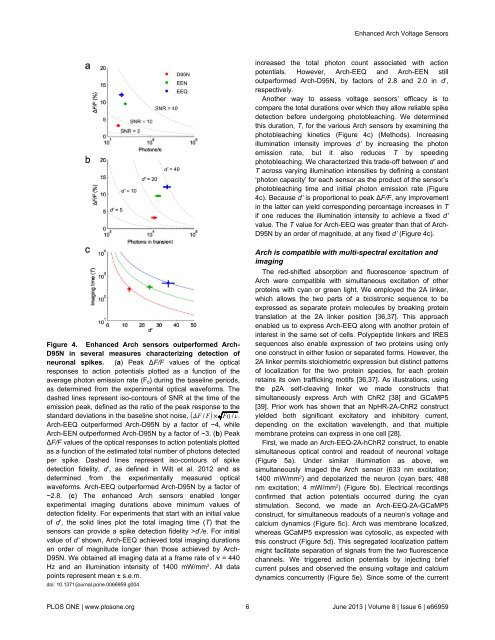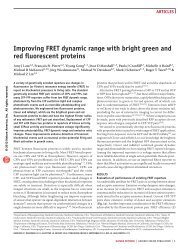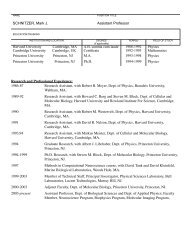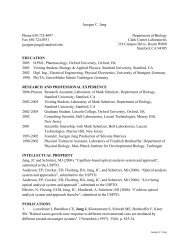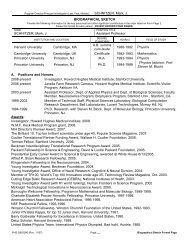Enhanced Archaerhodopsin Fluorescent Protein Voltage Indicators
Enhanced Archaerhodopsin Fluorescent Protein Voltage Indicators
Enhanced Archaerhodopsin Fluorescent Protein Voltage Indicators
You also want an ePaper? Increase the reach of your titles
YUMPU automatically turns print PDFs into web optimized ePapers that Google loves.
<strong>Enhanced</strong> Arch <strong>Voltage</strong> Sensors<br />
increased the total photon count associated with action<br />
potentials. However, Arch-EEQ and Arch-EEN still<br />
outperformed Arch-D95N, by factors of 2.8 and 2.0 in d’,<br />
respectively.<br />
Another way to assess voltage sensors’ efficacy is to<br />
compare the total durations over which they allow reliable spike<br />
detection before undergoing photobleaching. We determined<br />
this duration, T, for the various Arch sensors by examining the<br />
photobleaching kinetics (Figure 4c) (Methods). Increasing<br />
illumination intensity improves d’ by increasing the photon<br />
emission rate, but it also reduces T by speeding<br />
photobleaching. We characterized this trade-off between d’ and<br />
T across varying illumination intensities by defining a constant<br />
‘photon capacity’ for each sensor as the product of the sensor’s<br />
photobleaching time and initial photon emission rate (Figure<br />
4c). Because d’ is proportional to peak ∆F/F, any improvement<br />
in the latter can yield corresponding percentage increases in T<br />
if one reduces the illumination intensity to achieve a fixed d’<br />
value. The T value for Arch-EEQ was greater than that of Arch-<br />
D95N by an order of magnitude, at any fixed d’ (Figure 4c).<br />
Figure 4. <strong>Enhanced</strong> Arch sensors outperformed Arch-<br />
D95N in several measures characterizing detection of<br />
neuronal spikes. (a) Peak ∆F/F values of the optical<br />
responses to action potentials plotted as a function of the<br />
average photon emission rate (F 0 ) during the baseline periods,<br />
as determined from the experimental optical waveforms. The<br />
dashed lines represent iso-contours of SNR at the time of the<br />
emission peak, defined as the ratio of the peak response to the<br />
standard deviations in the baseline shot noise, ΔF F F ν.<br />
Arch-EEQ outperformed Arch-D95N by a factor of ~4, while<br />
Arch-EEN outperformed Arch-D95N by a factor of ~3. (b) Peak<br />
∆F/F values of the optical responses to action potentials plotted<br />
as a function of the estimated total number of photons detected<br />
per spike. Dashed lines represent iso-contours of spike<br />
detection fidelity, d’, as defined in Wilt et al. 2012 and as<br />
determined from the experimentally measured optical<br />
waveforms. Arch-EEQ outperformed Arch-D95N by a factor of<br />
~2.8. (c) The enhanced Arch sensors enabled longer<br />
experimental imaging durations above minimum values of<br />
detection fidelity. For experiments that start with an initial value<br />
of d’, the solid lines plot the total imaging time (T) that the<br />
sensors can provide a spike detection fidelity >d’/e. For initial<br />
value of d’ shown, Arch-EEQ achieved total imaging durations<br />
an order of magnitude longer than those achieved by Arch-<br />
D95N. We obtained all imaging data at a frame rate of ν = 440<br />
Hz and an illumination intensity of 1400 mW/mm 2 . All data<br />
points represent mean ± s.e.m.<br />
doi: 10.1371/journal.pone.0066959.g004<br />
Arch is compatible with multi-spectral excitation and<br />
imaging<br />
The red-shifted absorption and fluorescence spectrum of<br />
Arch were compatible with simultaneous excitation of other<br />
proteins with cyan or green light. We employed the 2A linker,<br />
which allows the two parts of a bicistronic sequence to be<br />
expressed as separate protein molecules by breaking protein<br />
translation at the 2A linker position [36,37]. This approach<br />
enabled us to express Arch-EEQ along with another protein of<br />
interest in the same set of cells. Polypeptide linkers and IRES<br />
sequences also enable expression of two proteins using only<br />
one construct in either fusion or separated forms. However, the<br />
2A linker permits stoichiometric expression but distinct patterns<br />
of localization for the two protein species, for each protein<br />
retains its own trafficking motifs [36,37]. As illustrations, using<br />
the p2A self-cleaving linker we made constructs that<br />
simultaneously express Arch with ChR2 [38] and GCaMP5<br />
[39]. Prior work has shown that an NpHR-2A-ChR2 construct<br />
yielded both significant excitatory and inhibitory current,<br />
depending on the excitation wavelength, and that multiple<br />
membrane proteins can express in one cell [28].<br />
First, we made an Arch-EEQ-2A-hChR2 construct, to enable<br />
simultaneous optical control and readout of neuronal voltage<br />
(Figure 5a). Under similar illumination as above, we<br />
simultaneously imaged the Arch sensor (633 nm excitation;<br />
1400 mW/mm 2 ) and depolarized the neuron (cyan bars; 488<br />
nm excitation; 4 mW/mm 2 ) (Figure 5b). Electrical recordings<br />
confirmed that action potentials occurred during the cyan<br />
stimulation. Second, we made an Arch-EEQ-2A-GCaMP5<br />
construct, for simultaneous readouts of a neuron’s voltage and<br />
calcium dynamics (Figure 5c). Arch was membrane localized,<br />
whereas GCaMP5 expression was cytosolic, as expected with<br />
this construct (Figure 5d). This segregated localization pattern<br />
might facilitate separation of signals from the two fluorescence<br />
channels. We triggered action potentials by injecting brief<br />
current pulses and observed the ensuing voltage and calcium<br />
dynamics concurrently (Figure 5e). Since some of the current<br />
PLOS ONE | www.plosone.org 6 June 2013 | Volume 8 | Issue 6 | e66959


